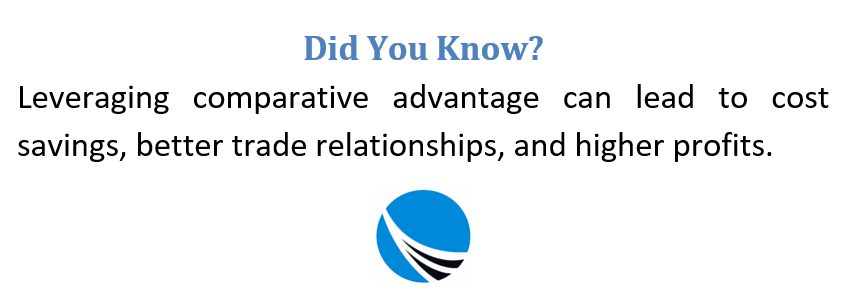In the fiercely competitive world of entrepreneurship, every edge counts. As a small business owner, you’re constantly seeking strategies to increase efficiency, reduce costs, and ultimately stand out in your niche. While many entrepreneurs strive to outperform others across the board, a more effective strategy is to recognize your business’s strengths and double down on what you do best.
This is where the concept of comparative advantage becomes a game-changer. It’s not about beating the competition in every area, but rather about excelling where you have a natural or strategic edge—and collaborating where others do better. By leveraging comparative advantage, your business can operate smarter, build profitable partnerships, and grow sustainably.
This article explores what comparative advantage means in a small business context, how to calculate it, how it differs from other strategic concepts, and how you can harness its potential while minimizing its risks.

What Does Comparative Advantage Really Mean?
Comparative advantage is a concept rooted in economic theory but holds very practical applications for businesses of all sizes. At its core, it describes a situation in which a business can produce a particular good or service at a lower opportunity cost than its peers.
Let’s define opportunity cost: it’s what you give up when you choose one path over another. If your bakery uses one hour to bake 50 cookies, but in that same hour you could have prepared 30 muffins, your opportunity cost of making cookies is the muffins you didn’t produce.
A business with a lower opportunity cost in making a certain product has a comparative advantage in that activity. Importantly, it doesn’t mean the business is the fastest or most efficient in absolute terms—it simply means it sacrifices less value to do that particular thing.
Understanding this principle helps small business owners streamline their efforts and focus resources where they’ll have the most impact.

How to Determine Your Comparative Advantage
To visualize this, imagine two small businesses that both make baked goods: Coffee Haven and Sweet Cravings.
- Coffee Haven can make 250 cups of coffee or 100 muffins in one day.
- Sweet Cravings can make 180 cups of coffee or 120 muffins in the same period.
Let’s determine the opportunity cost for each.
Coffee Haven:
- 1 cup of coffee = 100 muffins ÷ 250 = 0.4 muffins
- 1 muffin = 250 cups ÷ 100 = 2.5 cups of coffee
Sweet Cravings:
- 1 cup of coffee = 120 muffins ÷ 180 = 0.67 muffins
- 1 muffin = 180 cups ÷ 120 = 1.5 cups of coffee
By comparing these values, we can see:
- Coffee Haven sacrifices fewer muffins to make coffee (0.4 muffins vs. 0.67 muffins). Thus, it has a comparative advantage in producing coffee.
- Sweet Cravings gives up fewer cups of coffee to make a muffin (1.5 cups vs. 2.5 cups). Therefore, it has a comparative advantage in producing muffins.
If these two businesses focused solely on what they do comparatively better and traded their goods, they would both benefit from increased productivity and efficiency. This demonstrates how comparative advantage can encourage collaboration rather than unhealthy competition.
Contrasting Comparative Advantage with Other Strategic Advantages
Many business owners confuse comparative advantage with other types of advantages. Let’s explore how it differs from two commonly used terms: absolute advantage and competitive advantage.
1. Absolute Advantage
Absolute advantage refers to a business’s ability to produce more of a good or service using the same amount of resources, or the same quantity using fewer resources. It’s purely based on raw output or efficiency.
For example, if Green Leaf Farms can harvest 500 heads of lettuce a day using five workers, and Fresh Harvest only manages 400 with the same number of workers, Green Leaf has an absolute advantage in lettuce farming.
While absolute advantage is about productivity, it doesn’t consider what a business gives up to achieve that output. That’s where comparative advantage offers deeper insight.
2. Competitive Advantage
Competitive advantage is the ability to deliver products or services that consumers value more than what’s available from other providers. This may be through lower pricing, higher quality, unique branding, or a superior customer experience.
Securing a competitive advantage usually requires significant research, innovation, and strategic positioning. It’s not about internal efficiency but rather about how customers perceive and prefer your offering in the marketplace.
Comparative advantage, by contrast, is more internally focused. It’s about making the smartest use of your resources based on relative opportunity costs, regardless of customer perceptions or volume output.

Why Comparative Advantage Matters for Small Businesses
For small enterprises, where time, capital, and labor are often limited, making the right choices on where to allocate resources is critical. Focusing on areas where your business has a comparative advantage enables better resource management, smarter delegation, and higher returns.
Here are some tangible benefits of applying this principle in practice:
Improved Specialization
When a business zeroes in on tasks it can do more efficiently than others, it creates space for specialization. This often results in higher quality work, more consistent output, and opportunities to innovate in a focused area.
Cost Savings
Producing a good or service at a lower opportunity cost usually translates to lower overall expenses. This means fewer wasted hours, less material loss, and better use of labor—key factors that affect your bottom line.
Stronger Trade Relationships
Comparative advantage often encourages mutually beneficial partnerships. For example, a florist that excels at arrangements might partner with a wholesaler who specializes in sourcing flowers. Each focuses on their strength while fulfilling customer needs more effectively together.
Enhanced Profit Margins
Reducing the cost of production allows for greater pricing flexibility. You can either maintain current prices and enjoy larger profit margins or pass savings on to customers to stay competitive.
Boosted Innovation
When your business focuses on its strengths, it’s easier to identify and implement improvements. Innovation often stems from deep familiarity with a process or product, and this depth only grows when you’re not spread too thin across multiple unrelated activities.
The Potential Pitfalls of Comparative Advantage
While the concept has clear benefits, it’s important to be aware of its limitations and risks, especially for small businesses.
Risk of Dependency
Specializing based on comparative advantage often means relying on others to supply goods or services that you’ve decided not to produce yourself. If a supplier or partner fails to deliver due to logistical issues, labor shortages, or quality concerns, your operations can be severely disrupted.
Vulnerability to Market Shifts
Economic changes, evolving customer preferences, or global supply chain disruptions can suddenly make your comparative advantage less relevant or viable. If your business is too narrowly focused, it may struggle to adapt.
Increased Competition
When your business focuses on a niche, you may find yourself in direct competition with larger players who can leverage economies of scale. These businesses often have the ability to produce at lower per-unit costs simply because of their size, giving them a pricing edge even in areas where you thought you had a stronghold.
Diminished Flexibility
Over-specialization can make it harder for your business to pivot. A broader skill set or diversified service offering often provides more flexibility in times of uncertainty.
Smart Strategies to Maximize Comparative Advantage
The key to leveraging comparative advantage without becoming vulnerable lies in balance and strategic planning. Here are some ways small business owners can apply this principle thoughtfully:
- Analyze Your Workflows: Evaluate which activities produce the most value for your business per hour or per dollar spent. Redirect resources toward those tasks.
- Build Strong Partnerships: Work with reliable vendors or service providers who complement your strengths. Vet them carefully and keep backup options available.
- Stay Aware of Shifts: Monitor market trends and be prepared to reassess your comparative advantages as customer needs and industry standards evolve.
- Diversify Within Limits: While specialization is key, maintaining some diversity in your offerings or skills can safeguard your business against external shocks.
- Invest in Core Competencies: Allocate training, marketing, and R&D budgets toward the areas where you hold an advantage. Strengthening your strongest link often yields the best returns.
Final Takeaway: Compete Smarter, Not Harder
Success in business doesn’t always come from trying to outperform everyone in every area. Instead, it often comes from understanding your strengths and knowing when to collaborate instead of compete.
Comparative advantage offers small business owners a lens through which to make strategic choices—whether it’s about what to produce, what to outsource, or whom to partner with. When applied wisely, this principle allows you to maximize output, reduce inefficiencies, and build lasting relationships with others in your ecosystem.
Yes, it requires some planning and honest self-assessment. But the payoff—higher profits, stronger branding, and a more agile business—is worth it.
Remember, your goal isn’t to do everything. It’s to do the right things better than anyone else. And with comparative advantage on your side, you just might.
Frequently Asked Questions about Comparative Advantage
What is comparative advantage and why is it important for small businesses?
Comparative advantage is a business’s ability to produce a good or service at a lower opportunity cost than others. It’s important because it helps small businesses allocate resources efficiently, specialize in what they do best, and build profitable partnerships.
How does comparative advantage differ from absolute and competitive advantage?
Unlike absolute advantage, which focuses on producing more with fewer resources, and competitive advantage, which is based on consumer value, comparative advantage centers on producing goods with the least sacrifice in alternative output.
How can small businesses calculate their comparative advantage?
By comparing the opportunity costs of producing different goods or services. The business that gives up less of one product to produce another holds the comparative advantage in that area.
What are the risks of relying on comparative advantage?
Over-dependence on partners, vulnerability to market shifts, and exposure to competition from larger businesses are key risks. Strategic planning and diversification can help mitigate them.
